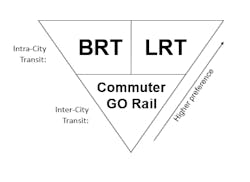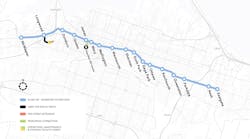Hamilton Task Force recommends further analysis of LRT, BRT options for city
Late last year, a proposed 14-km (8.7-mile), 17-stop light-rail line connecting downtown Hamilton, Ontario, along Main and King Streets and on Queenston Road was canceled by the province, which cited high cost estimates.
Accusations of betrayal were leveled at provincial leaders and calls for an investigation by the Auditor General of Ontario were made. The province had committed C$1 billion (US$718.945 million) to the project and vowed to keep the investment for transit in the city of Hamilton. The province established the Hamilton Task Force in January 2020 to develop a series of recommendations of where that investment could be applied.
Late last week, the task force’s work was completed with the publication of their final report, which includes 15 recommendations, including its initial preference for an intracity higher order transit project (LRT or bus rapid transit), but the report makes clear that further analysis is recommended before a final decision is made. A summary of all 15 recommendations is included at the end of this report.
"I am pleased that we are one step closer to ensuring that the province's commitment of C$1 billion in capital funding is invested in realistic and affordable transportation projects in Hamilton,” said Ontario Minister of Transportation Caroline Mulroney. “Our government remains committed to ensuring that the city of Hamilton gets the transit and transportation infrastructure it needs and deserves in order to connect people to places and jobs and ensure a seamless transit experience."
Hamilton Mayor Fred Eisenberger believes the report tilts toward the recommendation of the LRT option and “confirms what we already know, which is that LRT delivers the best bang for the buck in terms of transit, jobs and economic transformation.”
“The Task Force is clearly recommending LRT as the best option. LRT is shovel ready and ready to go ensuring economic benefits can be realized faster. BRT is a fallback which would require further study,” said Mayor Eisenberger. “The report is timely as we anticipate restarting our economy following the COVID-19 pandemic. The LRT project is the only shovel-ready project that will create thousands of jobs, economic uplift, increase affordable housing, cut CO2 emissions and will replace aging underground services such as water and waste water which would otherwise be the responsibility of local property taxpayers.”
The task force includes language within its second recommendation that LRT and BRT be considered equally and be evaluated concurrently to determine which is the best fit for Hamilton’s transportation needs. The task force identified funding as a main challenge surrounding pursuit of the LRT project and recommended analysis of a phased approach to the project.
“The task force has recommended a list of proposed projects that will improve access to the transportation network, reduce congestion and lower greenhouse gas emissions,” said Minister Mulroney. “In order to determine which of these projects will best serve the needs of Hamilton, the Task Force has also recommended further analysis. To this end, I am asking Metrolinx and Infrastructure Ontario to conduct a technical review of the project options contained in the report.”
A copy of the full report is available on the province’s website and a summary of the task force’s recommendations is below.
Summary of Hamilton Transportation Task Force’s 15 preliminary recommendations:
1. General recommendation to invest in higher-order transit “because these projects are expected to bring substantial benefits to the residents and businesses of the city of Hamilton.”
2. The Task Force’s initial preference is for an intra-city higher-order transit project, either light-rail transit or bus rapid transit, that addresses the city of Hamilton’s transportation needs such as current and future demand and congestion.
3. The Task Force recommends that contract award or project construction (for significant early work infrastructure at a minimum) begins within two years of the submission of this report, or March 16, 2022, in order to provide substantial benefits to the city of Hamilton in a timely manner.
4. Should intra-city higher-order transit projects be deemed not feasible following further analysis, then the Task Force further recommends inter-city higher-order transit in the form of 15-minute two-way all-day GO rail service to Hamilton GO Centre station.
5. The province of Ontario should also confirm a contract can be awarded or work can begin within two years on the delivery of two-way, all-day 15-minute service to Hamilton GO Centre Station.
6. The province of Ontario should engage other levels of government to identify all potential capital funding contributions for a potential LRT project.
7. The province of Ontario should explore opportunities to reduce the cost of the potential LRT project including alternative delivery models and alternative financing structures and sources (e.g., Canada Infrastructure Bank).
8. The Task Force recommends evaluating a phased approach to the original LRT project scope.
9. As a BRT option would be developed within the limitations of the King-Main St. corridor (B-line BRT) and Upper James St. corridor (A-line BRT), an initial priority of any work should focus on determining the technical feasibility of having fully separated bus lanes with platform-level boarding. The Task Force says it is not convinced any form of transit that runs in mixed traffic will deliver appropriate benefits to the people and businesses of Hamilton.
10. The province of Ontario should confirm if the BRT projects can be implemented within the next two years and identify the possibility of project phasing to begin early works.
11. Undertake a business case for the BRTs and priority bus options to get refined benefits and costs estimates.
12. The province of Ontario should refine cost estimates for 15-minute, two-way, all-day GO service to Hamilton GO Centre Station, given the wide range of current estimates.
13. The province of Ontario should explore the potential benefits and impacts of 15-minute, two-way, all-day GO service to Hamilton GO Centre Station, including economic development uplift and effect on current transportation network.
14. The province of Ontario should conduct further analysis for each of the recommended higher-order transit projects to understand the potential benefits for goods movement.
15. Upon selection of a project or projects, the province should work with the city to identify and fund complementary active transportation and local infrastructure projects that would improve the connectivity of the city’s transportation network.

Mischa Wanek-Libman | Group Editorial Director
Mischa Wanek-Libman is director of communications with Transdev North America. She has more than 20 years of experience working in the transportation industry covering construction projects, engineering challenges, transit and rail operations and best practices.
Wanek-Libman has held top editorial positions at freight rail and public transportation business-to-business publications including as editor-in-chief and editorial director of Mass Transit from 2018-2024. She has been recognized for editorial excellence through her individual work, as well as for collaborative content.
She is an active member of the American Public Transportation Association's Marketing and Communications Committee and served 14 years as a Board Observer on the National Railroad Construction and Maintenance Association (NRC) Board of Directors.
She is a graduate of Drake University in Des Moines, Iowa, where she earned a Bachelor of Arts degree in Journalism and Mass Communication.




